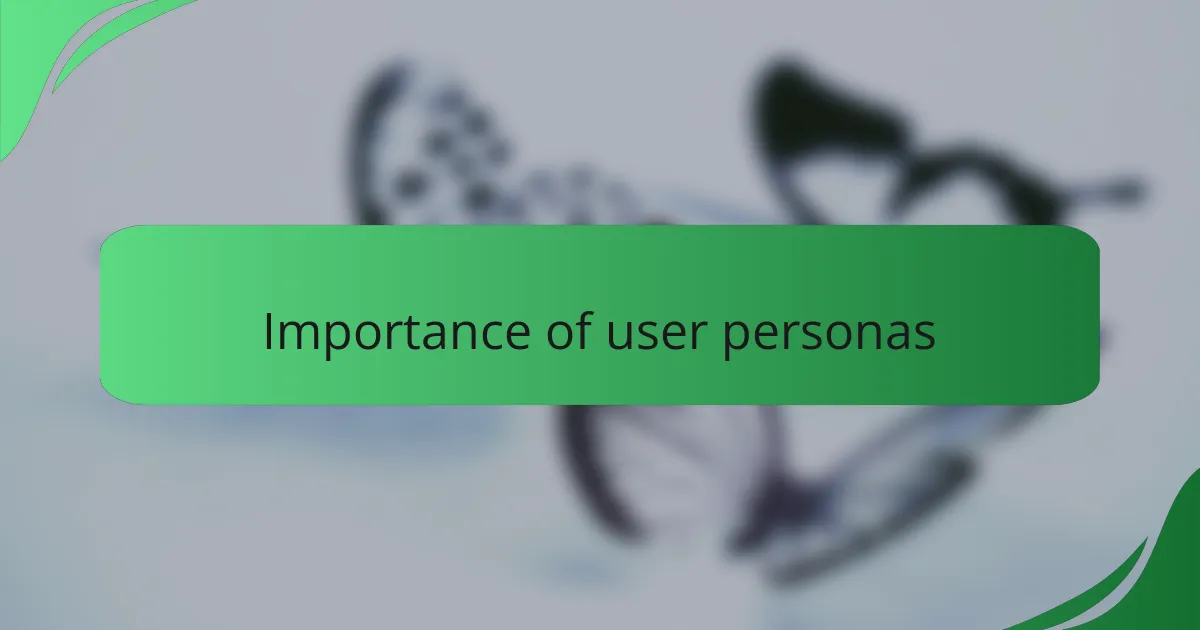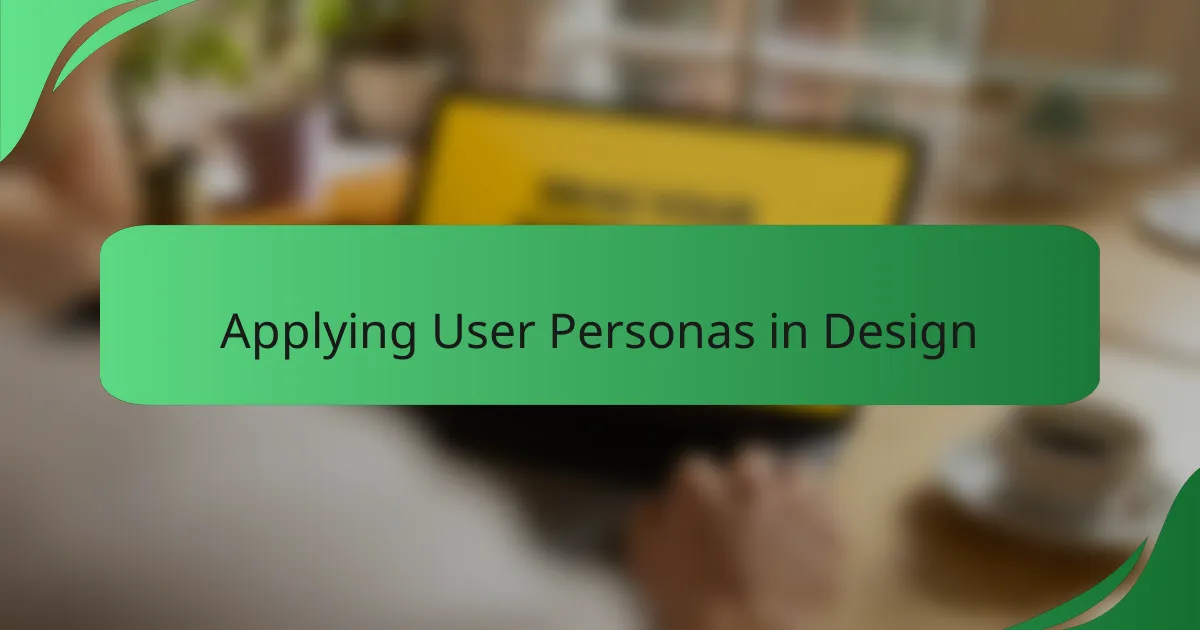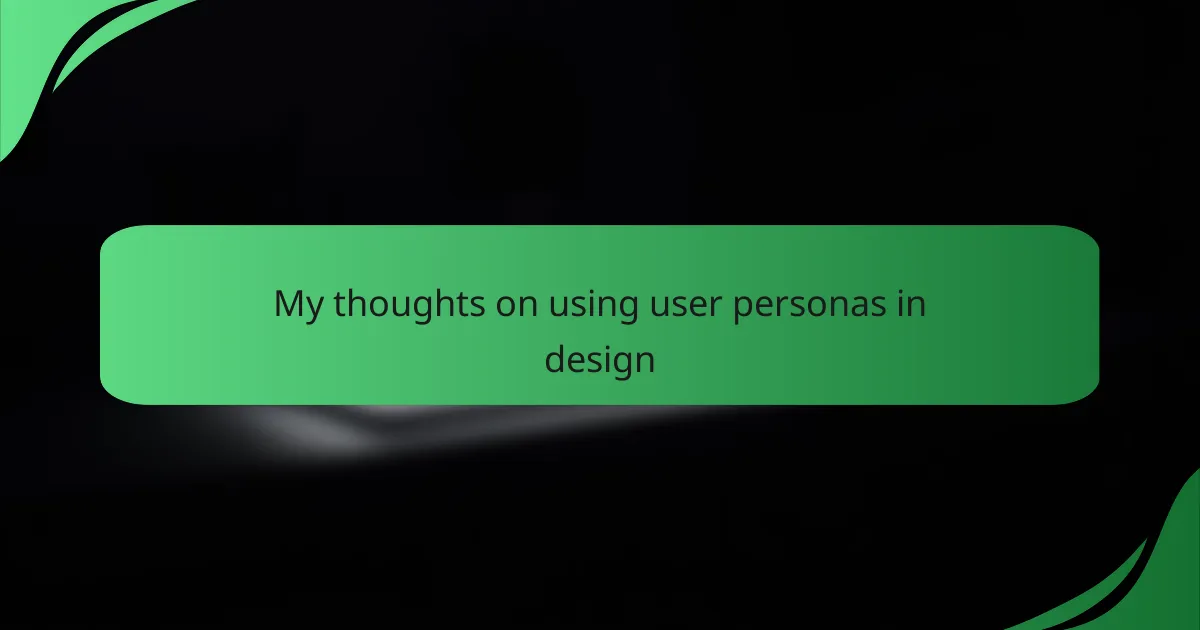Key takeaways
- User personas are essential for creating user-centered designs, offering clarity and empathy by representing real user needs and behaviors.
- Effective personas are based on thorough user research, including motivations and challenges, and should be regularly updated to remain relevant.
- Incorporating user personas throughout the design process fosters collaboration and ensures that design decisions are aligned with the user’s experience.
- Challenges include maintaining a balance between specificity and generality, keeping personas updated, and ensuring team alignment on their interpretations.

Understanding User Personas
User personas are fictional characters crafted based on user research to embody the various needs, goals, and behaviors of a target audience. From my experience, utilizing these personas helps designers channel their efforts toward creating more user-centered interfaces. When I first started using personas, I was amazed at how much clearer my design decisions became; they offered insight that significantly shaped the user experience.
Creating accurate personas involves gathering data through methods like interviews and surveys. I’ve found that the more comprehensive the research, the more realistic and relatable the personas become. This connection fosters empathy within the design team, as we start imagining real users’ journey through the interface.
In my design practice, I’ve seen how personas offer not just guidance but also clarity during discussions. When we reference a specific persona, it’s easier to make decisions that align with user needs rather than getting stuck in the creative mire.
| Aspect | User Personas |
|---|---|
| Purpose | To represent user characteristics and improve design focus |
| Creation | Based on user research and real data |
| Impact | Enhances empathy and user-centered design decisions |

Importance of User Personas
User personas play a crucial role in communicating the essence of the target audience. When I use personas during the design process, I feel grounded in the specific needs of users rather than lost in abstract concepts. Doesn’t it make sense to tailor our designs around real people? This human-centered approach ensures that we’re creating interfaces that resonate deeply with users.
In one of my projects, I created a persona based on extensive interviews, and it completely transformed our design strategy. Suddenly, design decisions weren’t just opinions; they were backed by the needs and preferences of a defined user. This level of clarity was a revelation for my team, as we often found ourselves referring back to this persona during heated discussions—focusing our dialogue on what truly mattered: the user’s experience.
Moreover, having a well-defined persona helps mitigate scope creep. I remember a time when a project started veering off course, but referring back to our persona brought us back on track. It served as a reminder of who we were designing for, streamlining our objectives and improving collaboration within the team. Isn’t it fascinating how a fictional character can bring real-world clarity to design conversations?

Creating Effective User Personas
Creating effective user personas is a crucial step in interface interaction design. From my experience, the best personas are based on real user data—this means conducting thorough research and engaging directly with your audience. When I first started using user personas, I realized how much more my designs resonated with users when I had a clear picture of who I was designing for.
I often recommend creating personas that not only reflect demographics but also include motivations and frustrations. This approach helps me empathize with users and ultimately design more intuitive interfaces. A persona that I developed early in my career, for instance, helped me understand a user’s fear of technology, leading me to simplify interactions that previously caused anxiety.
Here’s a comparison table highlighting key features of effective user personas:
| Feature | Description |
|---|---|
| Research-Based | Rooted in real user data to enhance authenticity. |
| Detailed Background | Includes motivations, goals, and challenges faced by users. |
| Dynamic | Regularly updated based on feedback and changing user needs. |

Applying User Personas in Design
Applying user personas in design really transforms how we approach interface interaction. For instance, when I started using personas in my projects, it became clear how much they bridge the gap between users and designers. They bring a human element into the design process, allowing us to empathize with our users’ needs and motivations. This not only results in more intuitive designs but also fosters a connection that resonates emotionally with users.
Through my experience, I’ve seen how user personas can clarify decision-making in design. When faced with competing ideas during a project, referring back to these personas kept us grounded. It turns complex differences in user needs into actionable strategies and helps the team stay focused on what truly matters—creating an engaging experience for every user.
Here’s a brief comparison table that highlights the advantages of using user personas versus traditional demographic data in design:
| User Personas | Traditional Demographic Data |
|---|---|
| Focus on user motivations and behaviors | Focus on general statistics |
| Encourages empathy and understanding | Often lacks emotional connection |
| Subject to refinement based on user feedback | Static, rarely updated information |

My Experience with User Personas
In my journey as a designer, utilizing user personas has dramatically enhanced my approach to interface design. I’ve found that creating detailed personas allows me to step into the shoes of my users, making it easier to anticipate their needs and challenges. For instance, when designing an app for busy professionals, I imagined “Sarah,” a graphic designer who juggles multiple projects. Her persona guided my choices, ensuring the features I implemented truly resonated with her daily experiences.
User personas help transform abstract user data into relatable characters, making design decisions feel more human-centered. I remember working on a project where user feedback initially felt overwhelming, but once I distilled the feedback into personas, it clarified my priorities. I think this connection is what makes user personas an essential tool—they allow us to design with empathy, ultimately leading to more intuitive interfaces.
| User Persona Benefit | Traditional Design Approach |
|---|---|
| Empathy and Understanding | Based on assumptions |
| User-Centric Decisions | Focus on features rather than user needs |

Challenges in Using User Personas
When working with user personas, one challenge I often encounter is achieving a balance between specificity and generality. While personas need to be relatable and specific enough to inform design decisions, they can become too narrow, limiting creativity. I remember a project where our persona became so detailed that it sidelined broader user needs.
Another issue is keeping personas up-to-date. Users evolve, and so do their preferences. I’ve seen teams struggle because they based decisions on outdated personas, assuming they still reflected real user behavior. It’s vital to regularly revise and validate these personas with fresh data.
A third challenge is team alignment. Sometimes different stakeholders have varying interpretations of a persona, leading to miscommunication in design goals. A common experience I’ve had is facilitating workshops to ensure everyone shares a unified understanding, which often reveals overlooked perspectives.
| Challenge | Impact |
|---|---|
| Specificity vs. Generality | Makes it hard to be creative and meet diverse needs. |
| Keeping Personas Updated | Can lead to decisions based on outdated information. |
| Team Alignment | Results in miscommunication and misaligned design goals. |

Tips for Successful User Persona Implementation
When implementing user personas, one of the most effective tips I can share is to involve real users in the process. This means conducting interviews or surveys to gather insights directly from your target audience. In my experience, this not only enriches the personas but also creates empathy within the design team, making the personas feel more like real people rather than just data points.
Another crucial aspect is to keep your personas updated. I learned the hard way that personas can become outdated quickly, especially in fast-paced industries. Regularly revisiting and refining them based on new user feedback can ensure that your designs remain relevant and user-focused.
It’s also helpful to integrate personas into every stage of your design process. I’ve found it beneficial to refer back to them during brainstorming sessions, design critiques, or usability testing. This aligns the team’s efforts and keeps the user at the forefront of design decisions, enhancing overall user experience.
| Tip | Details |
|---|---|
| Involve Real Users | Gather insights through interviews and surveys to create relatable and accurate personas. |
| Regular Updates | Continuously refine your personas based on new user feedback to maintain relevance. |
| Integrate in Design Process | Refer to personas throughout the design stages for focused and user-centered outcomes. |




